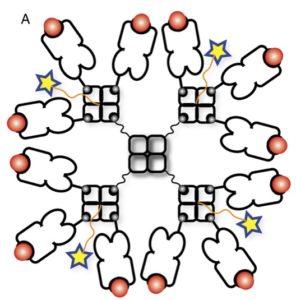T cells via the T cell receptor (TCR) recognise peptides (antigens) only when they are presented by major histocompability complex molecules (pMHC) on the surface of antigen presenting cells. The development of pMHC tetramers (conjugation of 4 pMHC monomers) enabled detection of antigen specific T cells in vitro without the need of stimulation. In spite of their wide use in T cell biology, a major caveat of using pMHC tetramers, is the inability to detect very rare T cells without the need of T cell enrichment, as well as detection of low binding affinity. To circumvent this, researchers led by Mark Davis aimed to develop pMHC dodecamers i.e. molecule that has 12 conjugated pMHC monomers.
Tetramers are useful tools that allow direct ex-vivo characterisation of T cells without the need of antigen stimulation. Ex-vivo antigen stimulation of cells can change the transcriptomic and protein expression profiles of T cells, which can confound results of the experiment. Studies have shown that αβ and γδ T cells that do not bind to tetramers are still capable of producing antigen-specific T cell responses, illustrating an underestimation antigen specific T cells when using tetramers.
Huang et al., used BL21 Escherichia coli to express pMHC molecules, that were refolded to form pMHC tetrameric proteins tagged with four cysteines. This was followed by biotinylation of the four cysteine molecules on each pMHC tetramer into a scaffold protein, which was mixed with streptavidin at different ratios to create pMHC dodecamers and other multimers. Researchers showed that dodecamers bound to T cells five fold better than tetramers, and exhibited longer TCR binding half-life of 90minutes, compared with 5 minutes for tetramers. Detection of rare T cell using tetramers often requires enrichment of CD4 T cells prior to tetramer staining. Huang et al., showed that increased affinity of the dodecamer enable detection of rare T cells without the need of T cell enrichment. Single cell mass cytometry, also known as CyTOF, uses heavy metal labeled antibodies to detect cell populations, and can detect up to 40 parameters per experiment. Previous experiments by the research group showed variable detection of pMHCII tetramer+ T cells. Using the pMHCII dodecamers Huang et al., were able to detect rare CD4 T cells at higher frequencies than tetramers using the CyTOF.
In summary, this study shows the utility of dodecamers to detect low TCR affinity T cells as well as the potential to replace tetramers with dodecamers for CyTOF experiments.
Journal Article: Huang et al., 2016. Detection, phenotyping, and quantification of antigen- specific T cells using a peptide-MHC dodecamer. PNAS
Article by Cheleka AM Mpande












